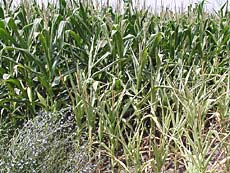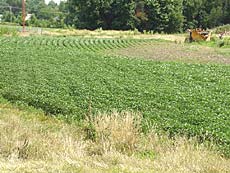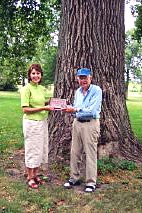|
Features,
Honors
& Awards, Ag
Announcements
Calendar,
Ag News Elsewhere
(fresh daily from the Web)
|
|
Features
|
|
Weekly outlook
Cattle markets
[JULY
25, 2002]
URBANA — Multiple concerns
face the U.S. cattle industry, according to a Purdue University
Extension marketing specialist. "Grain and protein prices are going
to be sharply higher this fall, with the precise magnitude to be
highly influenced by weather in the next several weeks," said Chris
Hurt.
|
|
"Poor pasture conditions and lack of
forage crops in the western Plains and Mountain States may also
result in further liquidation of cows and movement of calves to
market more quickly than planned.
"In addition, there remains uncertainty
about how consumers will respond to the decline in stock values. If
they begin to watch their food budgets more closely, beef demand
will be among the first to suffer."
Hurt’s comments came as he reviewed the
cattle markets. Finished cattle prices are expected to make a slow
recovery in the last half of 2002, following a disappointing
performance since late 2001. On the other hand, feeder cattle are
expected to experience little price increase as a larger calf crop
and higher feed prices offset the potential modest gains in finished
cattle prices.
"Calf prices are also expected to
struggle, with this fall’s prices being nearly $10 per hundredweight
below prices in the fall of 2001," said Hurt.
In its cattle report for July, the USDA
reported that the total number of cattle and calves in the country
was down only 0.6 percent. Even with much lower calf prices and
drought conditions in much of the Plains and Mountain States, the
total number of cows is down only fractionally, and the anticipated
calf crop this year is actually up by 0.3 percent. Beef cow numbers
on July 1 were down 0.4 percent, but milk cow numbers were up 0.5
percent.
"Milk producers indicated that they
intend to expand the herd even more, as the number of milk
replacement heifers is up 2.8 percent," said Hurt. "This reaction,
especially among small and moderate-sized producers, reflects the
strong profits last year and, perhaps, the new government milk price
supports.
"Beef producers, on the other hand,
intend to keep the size of the breeding herd about the same, as beef
replacement heifer numbers were unchanged from last year at this
time."
Beef production for 2002 is now
expected to reach 26.6 billion pounds, a 2 percent increase from
last year. The slaughter rate may finally taper off a bit in the
final quarter of this year, as the number of market steers and
heifers weighing over 500 pounds on July 1 was down about 2 percent.
"High marketing weights have plagued
the cattle market since last fall and will be an important factor in
price determination in the coming year," said Hurt. "As an example,
in the first half of this year the number of cattle marketed was
unchanged, but higher weights added 3.6 percent to the total beef
supply.
"Low-priced feed and unfulfilled
hopes for a recovery in finished cattle prices seem to be the
explanation. It is anticipated that weights will remain about 1 to
2 percent higher this summer but then drop back closer to
unchanged for the fall and winter as a result of sharply higher
feed prices."
Some recovery in finished cattle prices
is expected this fall. Nebraska 1,100- to 1,300-pound choice steers
averaged only $65.58 in the second quarter of 2002. The price is
expected to improve only about $1 for a summer average, with prices
finally increasing in September. The fall quarter is expected to see
prices recover into the higher $60s.
"Some further modest recovery can be
expected in the first half of 2003, with prices averaging near $70
in the first quarter and in the extremely low $70s in the second
quarter," said Hurt. "Given normal seasonal price tendencies, this
would mean that prices in late March or early April could reach the
low to mid-$70s for some daily highs."
Feeder cattle prices are expected to be
well below their previous-year levels over the coming 12 months.
Lower prices will be a result of a modestly larger 2002 calf crop,
the sluggish recovery in finished cattle prices, and higher feed and
forage prices. Prices for Oklahoma City steers weighing in the 750-
to 800-pound range are expected to average in the low $80s per
hundredweight this summer but drop to the very high $70s for the
fall. During the first half of 2003, prices are expected to be in
the mid- to higher $70s. Prices for the next 12 months are expected
to be about $5 per hundredweight lower than in the previous 12
months.
[to top of second column in this
article]
|

"Lower-priced feeder cattle will also
likely result in lower-priced calves over the next year," said Hurt.
"Prices for Oklahoma City 500- to 550-pound steers, as an example,
are expected to be in the low $90s per hundredweight this summer but
drop to the higher $80s in the fall. Prices during the first half of
2003 are expected to be in the lower $90s.
"As an
example of the changed price prospects for brood cow producers,
these calves averaged $98 per hundredweight last fall but are
expected to be only $88 this fall. Prices for the next 12 months are
expected to be about $9 per hundredweight lower, on average, than in
the previous 12 months. Prices for eastern Corn Belt calves at
auction markets tend to be $3 to $5 lower than Oklahoma City."
[U
of I news release]
|

Tuesday, July 30
6:00 pm
- Luehr's Ideal Rides Bargain
Night
--All rides take
1 ticket
- Veterans Pass in Review - (Grandstand)
7:30 pm
- Logan County
Queen Pageant
Wednesday, July 31
9:00 am
- Open Horse Show
7:30 pm
- Talent Contest
Thursday, August 1
1:30 pm
- Harness Racing
6:00 pm - closing
- Luehr's
Ideal Rides Ride-A-Thon Night
6:30 pm
- Tractor Pull
Friday, August 2
1:30 pm
- Harness Racing
- Senior Citizens Day
7:30 pm
- 4-H Night-- Calf,
Pig, Chicken & Goat Scrambles
Saturday, August 3
8:00 am
- 3 on 3 Basketball
- Chili Cook-off
1:00 pm - 5:00 pm
- Carnival Opens--"Kids Bargain Afternoon"
1:00 pm
- Kids Day--South end of Fairgrounds,
Special
Events Building
- Harness Racing
7:00 pm
- Country Music
Show--Wade Dooley
Sunday, August 4
1:00 pm
- Harness Racing--Downstate Classic Day
- Luehr's Ideal Rides
Family Day
--All rides take 1 ticket
2:00 pm
- 4-H Livestock Auction
6:00 pm
- Demolition
Derby
To order reserved Box &
Track seats, call 217-732-3311
Illinois' Cleanest & Finest
County Fair |
|
|
 |
|
|
Crop conditions critical
[JULY
23, 2002]
What a difference an inch of
rain makes! Of course portions of Logan County have received more
than five inches in the past week, while other areas are
significantly below those totals. Both corn and soybeans are in
critical periods of their growth and development now. The rains of
last evening were "million dollar" rains that will help with corn
kernel development and soybean pod set.
|
|
Corn is just somewhere around the
pollination stage. I say "somewhere," since some corn is just
finishing up, while other fields are just beginning. It’s amazing
what it does to have three planting periods, a month apart. Corn
that is under severe moisture stress may not have live pollen shed
at the same time that silks are available to receive the pollen.
Silk for the tips of ears emerges last. In some years the pollen is
gone before the silk for the kernels at tip is exposed, leading to
barren tips.

[Photos provided by John Fulton]
Soybeans are in the early pod-set
stage, with many varieties being much shorter than normal. Height of
plants doesn’t provide any indicator of yield, as the nodes are much
closer together on plants when the beans are grown under stress.
Severely stressed soybeans also tend to have more blooms fall off
without setting pods. Don’t get too alarmed at blooms that don’t set
pods, since less than a quarter of the blooms set pods in a good
year.
[to top of second column in this
article]
|
Spot inspections of corn pollination
this year show pollination to be surprisingly good. Many ears have
shown over 90 percent of available kernels pollinated. Corn that
would be suspect for pollination is the corn yet to pollinate. It
has been under more moisture stress because of reduced root
development. It has also been under more stress while the
reproductive portions of the plant have been forming in the plant.
These later-planted fields can be assessed in about two weeks to
see their progress. Each stage of crop development limits yield
potential. Early to mid stages were stressed, while corn should be
good for a few weeks.

In addition
to weather, insects and their relatives are creating challenges. We
have had Japanese beetles, corn rootworm beetles, aphids and now
spider mites causing damage. Limited treatment has been occurring
for these problems. When determining whether treatment is justified,
the stage of crop growth, threshold of insects, cost of treatment,
value of crop and the effectiveness of treatment must all be taken
into account.
[John
Fulton]
|
|
|
Specialty crops tour
‘Money Does Grow on Trees’
[JULY
23, 2002]
URBANA — A variety
of specialty crops will be featured on the fourth in a series of
sustainable agriculture field trips, on Tuesday, Aug. 6.
|
|
The tour will begin
at Frey Produce north of Keenes, Ill., at 9:30 a.m. Owner Sarah Frey
is a commercial buyer and packager of fruit and produce.
Dave Johnson,
forester with the Illinois Department of Conservation, will give a
talk entitled "Money Does Grow on Trees." He will be presenting
information on how farmers can grow nuts, acorns and other seeds for
the Illinois Department of Conservation for their tree nursery. And,
Martin Barbre and Brad Greenwalt will provide information on growing
low-nicotine tobacco. Barbre farms approximately 26 acres of tobacco
in Illinois.
The tour will then
move to the Mark Donoho farm. Donoho grows pumpkins as an
alternative to corn and soybeans. He has grown them for Frey produce
for three years.
The day will end with
a tour of the Genkota Winery in Mount Vernon. Owner Brad Drake will
describe the grape and wine production at the winery. Allan Dillard,
who has his own winery near Carbondale, will also be available to
answer questions.
While the tour itself
is free, there is a $5 advance registration required for the lunch,
or $10 on the day of the tour. To register in advance, contact Walt
Townsend at (618) 897-2560.
To get to Frey
Produce, drive east of Mount Vernon on Route 15 to Keenes, then turn
north toward Orchardville, continue 8½ miles, then turn west for two
miles.
[to top of second column in this
article]
|
The specialty crop
field trip is part of the 2002 Sustainable Agriculture Tours,
sponsored by the Agroecology/Sustainable Agriculture Program at
the University of Illinois, the North Central Region Sustainable
Agriculture Research and Education Professional Development
Program and the Illinois Small Farm Task Force.
"The tours will give
people a chance to see a variety of sustainable agriculture
operations in action," said Deborah Cavanaugh-Grant, research
specialist at the University of Illinois in the College of
Agricultural, Consumer and Environmental Sciences.
"Then, in November,
we’ll be offering two identical workshops, on the 13th in Effingham
and on the 14th in Peoria, that will look at the big picture and try
to assimilate the practices presented on the summer tours. But each
of the tours and the workshops stand alone, so people can attend one
or all of them."
Cavanaugh-Grant said
that the next field trip, on Sept. 10, will be about fee hunting,
and the final field trip, on agri-tourism, will be on Oct. 11.
Visit
http://www.aces.uiuc.edu/asap/ for more information or contact
Deborah Cavanaugh-Grant at (217) 968-5512; e-mail:
cvnghgrn@uiuc.edu.
[U
of I news release]
|
|
|
Project aims to maintain disease resistance in Illinois soybeans
[JULY
22, 2002]
URBANA — One of the
most troublesome plant diseases in many Illinois fields is
Phytophthora rot, which can infect and kill soybean plants anytime
from planting to harvest. This disease has been largely controlled
by planting soybean varieties with Rps resistance genes.
|
|
But recently the Rps
genes have been losing some of their efficiency in several states
across the Midwest, creating the potential for renewed outbreaks of
the disease in soybean fields.
To counter this
problem, researchers from University of Illinois Extension recently
launched a project aimed at determining if the strains of
Phytophthora in Illinois are developing the ability to kill soybean
plants with the available Rps resistance genes. Funding for this
project has been provided by the Illinois Soybean Checkoff Board.
"With help from seed
company representatives and regional Extension educators, we have
collected and tested more than 200 soil samples from soybean fields
with a history of Phytophthora or similar seedling health problems,"
said Dean Malvick, plant pathologist with U of I Extension. "Those
samples came from more than 20 counties across the state."
The researchers have
obtained isolates of the disease-causing pathogen from many of those
samples and have tested them against commercial soybean varieties
with the three types of Rps resistance genes.
[to top of second column in this
article]
|
"As expected, we
found that many of the isolates from Illinois can defeat the first
of those resistance genes and that a smaller number can defeat the
second type," Malvick said. "Unfortunately, we have found in our
preliminary work that a few aggressive isolates can defeat all
three of the resistance genes commonly found in commercial soybean
varieties sold in the state. Although these aggressive isolates
exist in Illinois, we still do not know for sure how much damage
they may be causing."
He notes, however,
that the aggressive isolates do not appear to be widespread in the
state and that two of the three resistance genes are still effective
in most cases.
"We plan to continue our research to
identify the various races of Phytophthora in Illinois," Malvick
said. "Those results will help with selection of soybean varieties
with appropriate types of resistance and will be of real value for
breeders developing soybean varieties with Phytophthora resistance
best suited for the state."
[U
of I news release]
|
|
|
State’s livestock industry must
adapt or decline, study indicates
[JULY
20, 2002]
URBANA — Opportunities for a
solution to the decline of the Illinois livestock industry exist if
the industry can develop models that address the demands of the
modern agri-food supply chain while meeting community standards for
environmental stewardship, said a University of Illinois Extension
agribusiness management specialist.
|
|
"An economic impact analysis tells a
complex story of an industry in decline but at the same time an
industry with significant impact," said Peter Goldsmith, who is
studying the industry with funding support from the Illinois Council
for Food and Agricultural Research. "If the industry maintains the
status quo, the negative trends will persist," he said.
Goldsmith’s comments came as he
participated in an Illinois Livestock Business Development
Conference, sponsored by the Illinois Coalition for Animal
Agriculture. The meeting was in Bloomington earlier this month.
Livestock agriculture in Illinois has a
total economic impact at the production level of more than $2.7
billion in output and more than 37,000 full-time equivalent
employees. The impact is greater proportionally in some areas. For
example, livestock comprises more than 25 percent of Carroll
County’s economy and almost 18 percent of that county’s employment.
"When the meat and dairy processing
sectors are added to the statewide economic picture, the impacts
increase fivefold," said Goldsmith. "In 1999, meat and dairy
processing contributed more than $15 billion in total economic
impact and had a total employment impact on more than 80,000 jobs.
"Combining the livestock and meat and
dairy processing sectors creates a complex that impacts more than
118,000 jobs, has total economic impact of more than $18 billion,
and represents 2.32 percent of the state’s economy."
However, over the past 20 years animal
agriculture has declined in the Midwest as a result of a number of
factors, including population shifts, scale economies and novel
business models leading to greater coordination and integration.
"The structural change in Midwest
agriculture has not only resulted in a real decline in the value of
Illinois livestock marketing but a relative decline as well," he
noted.
"Exacerbating the situation is the
heightened conflict over rural amenities. Whereas historically
livestock was an integral part of the rural landscape, shifts in
rural population and a trend toward enclosed livestock production
have made animal agriculture a public policy issue."
Goldsmith’s research is focused on
determining if livestock agriculture has a future role in rural
economic growth in Illinois. If so, how must it adapt to reflect the
new realities of rural life as well as the modern agri-food supply
chain?
[to top of second column in this
article]
|
One promising area involves linkages
between livestock and upstream and downstream sectors in the food
chain.
"While downstream the processing sector
purchases more than $1.2 billion of Illinois livestock inputs
annually, this represents only 28 percent of the livestock commodity
inputs needed by meat and dairy processing," said Goldsmith.
"Significant deficit commodities are beef and dairy, contributing
only 20 percent and 18 percent, respectively, of local industry
demand."
Livestock may also play a role in rural
economic development.
"Addressing the livestock enterprise
siting question is critical," he noted. "There are numerous
alternative destinations, nationally and internationally, for
investment capital in livestock production. Creating a more
favorable business environment is essential to restoring livestock
numbers and consequently the economic strength of many rural
communities."
Now is the time for new thinking in the
state’s livestock industry.
"It behooves the livestock sector to
explore novel relationships with meat and dairy processing to access
their supply-chain knowledge," he said. "In terms of local demand,
markets in Chicago and St. Louis offer interesting opportunities in
the retail, direct marketing and restaurant segments.
"Linkages with the grain sector also
offer opportunity. Tremendous expansion of the ethanol industry is
planned for the state. Marketing dried distillers’ grains will be a
significant challenge, and partnering with the ethanol industry also
offers interesting opportunities."
In addition to studying the economic
impact and future of the state’s livestock industry, Goldsmith will
soon begin a project that involves understanding community standards
in order to improve siting of livestock facilities.
"The study will help the industry
understand and apply the concept of ‘community standards’ as they
seek to reverse the flow of investment capital in livestock
production," said Goldsmith.
The full
report, "Economic Impact of Illinois’ Livestock Industry: Supply
Chain Linkages," will be available in August. People interested in
copies are invited to contact Sue Esposito at (217) 333-5506.
[U
of I news release]
|
|
|
Honors
& Awards
|
|
 There
are some ‘treemendous’ There
are some ‘treemendous’
trees in Logan County
[JULY
20, 2002] The
2002 Treemendous Tree Contest sponsored by the Logan County Master
Gardeners has determined winners by species and an overall winner.
The largest tree scored was a tulip poplar owned by Hoblit Farms of
Atlanta. The tree measured 129 feet tall, had a branch spread of 79
feet 7 inches, and a circumference of 16 feet 11 inches. The tree
garnered a composite score of 352 points based on these
measurements.
|
|
Other winners were Jim McKown with a
black walnut tree with a composite score of 203 points, Hoblit Farms
with a white oak earning a score of 241, Daris Knauer’s red oak with
a score of 252, Stephen Miller with a score of 260 on his ash tree,
Jim Sparrow’s silver maple with a score of 250, and John Fulton’s
hackberry with a score of 214.
|
Winners will
receive plaques sponsored by contest chairman Walt Ebel. The contest
was promoted by Walt and the Master Gardeners to identify and
preserve large trees in the Logan County area.
[John
Fulton] |
|
|
National FFA scholarship awarded to
local student
[JULY
17, 2002]
INDIANAPOLIS, Ind. — FFA’s national organization awarded
a $1,000 Valent BioSciences Corporation scholarship to Kent Leesman
of Hartsburg-Emden High School. Valent BioSciences sponsors the
scholarship as a special project of the National FFA Foundation.
Kent plans to use the funds to pursue a degree in agronomy at
University of Illinois in Urbana-Champaign.
|
|
The Valent
BioSciences scholarship is one of 1,178 awarded through the FFA’s
national scholarship program this year. Currently, 187 corporate
sponsors generously contribute more than $1.9 million to support the
program. This is the 18th year that scholarships have been made
available through the National FFA Foundation by business and
industry sponsors to reward and encourage excellence and enable
students to pursue their educational goals.
Scholarship
recipients were selected from more than 7,000 applicants from across
the country. Selections were based on the applicant’s academic
record, FFA and other school and community activities, supervised
agricultural experience program in agricultural education, career
plans and financial need.
[to top of second column in this
article]
|
FFA is a national youth
organization of 457,278 student members preparing for leadership and
careers in the science, business and technology of agriculture.
There are 7,312 local chapters in all 50 states, Puerto Rico and the
Virgin Islands. FFA strives to make a positive difference in the
lives of students by developing their potential for leadership,
personal growth and career success through agricultural education.
Visit www.ffa.org for more information.
[FFA
news release]
|
|
|
Logan
County 4-H Shows
|
|
|
Ag
Announcements
|
|
Special
baking contests
at state fair
[JULY
1, 2002]
Contestants are
invited to prepare gingerbread houses and Spam recipes to enter at the
Illinois State Fair in August.
|
|
Awards will be given for the most creative
entries in the Brer Rabbit® Molasses Gingerbread House Contest at
the state fair. Both beginners and gingerbread house enthusiasts are
invited to compete for cash and prizes. In 2001, judges picked
winning entries ranging from traditional to elaborate, including a
castle, a detailed tree house with garden and another resembling the
"Old Woman in a Shoe." Any theme entry is welcome that uses Brer
Rabbit molasses and is up to a foot tall, wide and deep, base not
included. Entrants must also bake and enter one dozen gingerbread
cookies.
Winners are selected based on
appearance (50 percent), originality and creativity (40 percent),
and taste (10 percent). Creators are awarded $150 for first place,
$75 for second and $25 for third. People of any age may enter, with
one entry per person or group. Several people may work on one entry,
but one person represents the group.
[to top of second column in this
article]
|
The Illinois State Fair will be one of
70 fairs hosting the Spam® Oven Roasted Turkey Contest. Using the
Spam turkey and up to nine other ingredients, contestants are to
create an original main dish, appetizer, casserole, stew, stir-fry,
salad sandwich or any other recipe. To focus on convenience, cooking
time may not exceed 30 minutes.
Judges select winners based on taste
appeal (40 percent), appearance (30 percent) and originality (30
percent). The three best entries win cash awards of $150, $50 and
$25, and first-place winners advance to national judging for a
$2,500 shopping spree and an all-expense-paid trip to Minneapolis.
To enter
either contest, contact the entry department at the Illinois State
Fair, 782-6661, by July 15. More details for the gingerbread contest
are on page 90, and those for the Spam contest are on page 86 of the
general premium book.
[News release]
|
|